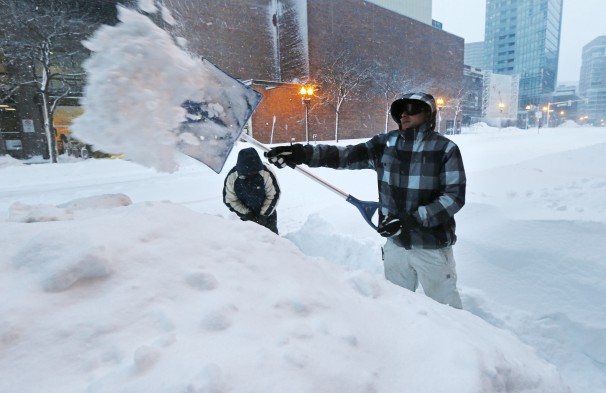link to story
State officials in Massachusetts took the rare step of ordering cars off the streets in advance of the storm, while in Long Island, hundreds of commuters were surprised and stranded by the blizzard, which dumped two to three feet of snow on the region.
The storm claimed at least four lives and added to the march of extreme weather events in the past year that includes Hurricane Sandy, a deep drought, the hottest U.S. year on record and widespread wildfires in the West.
Authorities in Boston said an 11-year-old boy died from carbon-monoxide poisoning when he and his father warmed up from snow shoveling by huddling inside a car whose exhaust was blocked by snow. In New York’s Columbia County, a man plowing on a tractor died when he ran off the road. A pedestrian in Poughkeepsie, N.Y., died after he was struck while walking along a snowy roadside, and a Connecticut man collapsed and died while shoveling snow, according to news reports.
The storm rumbled up the East Coast along the path of most of New England’s famed nor’easters. It lashed seafront towns, sent surges of water onto streets at high tide, and departed with tons of precious beachfront property.
But the combination of lucky timing — the storm arrived on a Friday — and advance warning gave residents plenty of time to hunker down and get off the roadways. That limited the problems and should allow a straightforward cleanup. Authorities praised Massachusetts Gov. Deval Patrick’s decision to order cars off the streets Friday, clearing the roads for emergency crews.
“I’m happy to report the city, so far, has weathered the storm well,” Boston Mayor Thomas M. Menino said at noon Saturday. New England’s largest city was dead center on the storm’s path but escaped major power outages and flooding.
Towns north and south of Boston fared worse. Waves chopped away the foundations of beachfront homes in Massachusetts communities of Sandwich, Hull and Scituate. Most of those homes were vacated by residents wary of the churning sea before a mid-morning high tide sent salty water racing through streets.
Power companies reported that 600,000 customers had lost power by Saturday morning. Utility crews remained poised inside motels, their bucket trucks parked, until the howling wind quieted to a whisper and the power workers could safely reach lines encased in ice and snow.
Governors in all the New England states declared states of emergency, opened up shelters, and shut down airports and public transport.
The storm rivaled the historic grip of the Blizzard of ’78, a 36-hour whiteout that New Englanders cite as a high-water mark of grim winters. This year’s storm plowed up the Atlantic coast and embraced Boston with sweeping arcs of snow and wind that reached into Vermont, New Hampshire and southern Maine on Friday night.
When it passed, it had delivered almost 25 inches at Boston’s official measuring station at Logan International Airport, 2 1/2 inches short of a record. But other towns in Massachusetts and New Hampshire reported snow totals of as high as 34 inches. Milford, Conn., recorded 38 inches.
Regardless of its place in the record books, the blizzard is likely to add to the discussion about the increasing frequency of unusual weather events globally, ranging from floods in Pakistan that sent 20 million people fleeing to the stunning melt-off of nearly half the Arctic ice cap, events consistent with climate change.
New York City, still recovering from Sandy’s staggering blow, “dodged a bullet,” Mayor Michael R. Bloomberg (I) said Saturday morning.
“I think it’s fair to say that we were very lucky. We certainly avoided the worst of it and our thoughts go out to the people of Connecticut, Rhode Island, Massachusetts, New Hampshire, Vermont, Maine,” the mayor said. “If we can do anything to help them we certainly will. . . . When we were in trouble the country came to our aid, and we want to make sure we do the same.”
But parts of Long Island were hit with more than 30 inches of snow, catching commuters by surprise and stranding some in their cars for up to 12 hours.
New York Gov. Andrew M. Cuomo asked for help from other towns to help dig out eastern Long Island. About 200 people were stranded in cars Friday night in Suffolk County, according to the Associated Press, prompting questions of whether the roads should have been closed.
The decision by Patrick to order a ban on non-essential travel throughout Massachusetts on Friday afternoon was the first time such powers had been evoked in the state since the Blizzard of ’78, issued then after hundreds of stranded cars blocked cleanup of the roadway.

